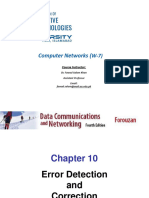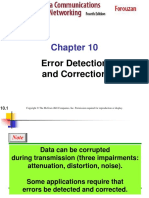0 ratings0% found this document useful (0 votes) 78 views29 pagesError Detection and Correction
Notes for Computer Networks
Copyright
© © All Rights Reserved
We take content rights seriously. If you suspect this is your content,
claim it here.
Available Formats
Download as PDF or read online on Scribd
FLOW AND ERROR CONTROL
The most important responsibilities of the data link
layer are flow control and error control. Collectively,
these functions are known as data link control.
Flow Control
Error Control
Flow control refers to a set of procedures used to
restrict the amount of data that the sender can send
before waiting for acknowledgment.
Error control in the data link layer is based on
automatic repeat request, which is the retransmission
of data,when an error is detected.�@
Data can be corrupted during transmission. Some
applications require that errors be detected and
corrected.
Types of Errors
Redundancy
Detection Versus Correction
Forward Error Correction Versus Retransmission
Coding
Modular Arithmetic
In a single-bit error, only 1 bit in
the data unit has changed.
A burst error means that 2 or more bits
in the data unit have changed�@
To detect or correct errors, we need to
send extra (redundant) bits with data.
Redundancy can be achieved thro’ coding schemes.
Broad categories are:
1. Block Coding
2. Convolution coding
We concentrate on block codes and leave convolution
codes to advanced texts.�The structure of encoder and decoder
Sender Receiver
Decoder
Message Message
K correct or
discard
[eee]
Unreliable transmission
Message and redundancy >| Received information
In modulo-N arithmetic, we use only the integers in
the range 0 to N -1, inclusive.�In block coding, we divide our message into blocks,
each of k bits, called datawords. We add r redundant
bits to each block to make the length n =k + r. The
resulting n-bit blocks are called codewords.
Error Detection
Error Correction
Hamming Distance
Minimum Hamming Distance�Datawords and codewords in block coding
k bits kbits cee k bits
2 Datawords, each of k bits
n bits n bits eee n bits
2 Codewords, each of n bits (only 2 of them are valid)�Process of error detection in block coding
k bits
Sender
Dataword
Generator
Unreliable transmission
Receiver
k bits
Extract
Checker
Discard
Codeword
n bits�‘Structure of encoder and decoder in error correction
Sender
Receiver
Encoder
Dataword
K
k bits
Correct
Checker
Generator |
Unreliable transmission�Example
Let us add more redundant bits to Example 10.2 to see if
the receiver can correct an error without knowing what
was actually sent. We add 3 redundant bits to the 2-bit
dataword to make 5-bit codewords. Table 10.2 shows the
datawords and codewords. Assume the dataword is 01.
The sender creates the codeword 01011. The codeword is
corrupted during transmission, and 01001 is received.
First, the receiver finds that the received codeword is not
in the table. This means an error has occurred. The
receiver, assuming that there is only 1 bit corrupted, uses
the following strategy to guess the correct dataword.�Example @
1. Comparing the received codeword with the first
codeword in the table (01001 versus 00000), the
receiver decides that the first codeword is not the one
that was sent because there are two different bits.
2. By the same reasoning, the original codeword cannot
be the third or fourth one in the table.
3. The original codeword must be the second one in the
table because this is the only one that differs from the
received codeword by 1 bit. The receiver replaces
01001 with 01011 and consults the table to find the
dataword 01.�A code for error correction
[ Dataword Codeword
00 00000.
01 01011
10 10101
Tal 11110�Example _
Find the minimum Hamming distance of the coding
scheme in table above
Solution
We first find all the Hamming distances.
00000, 11110)
d0101, 11110)
The dpi, in this case is 3.�@)
Example _ @
Our block code scheme has d,,;, = 3. This code can detect
up to two errors. Again, we see that when any of the valid
codewords is sent, two errors create a codeword which is
not in the table of valid codewords. The receiver cannot
be fooled.
However, some combinations of three errors change a
valid codeword to another valid codeword. The receiver
accepts the received codeword and the errors are
undetected.�An error-detecting code can detect only the types of errors for
which designed; other types of errors may remain
undetected.
The Hamming distance between two words is the number of
differences between corresponding bits.
The minimum Hamming distance is the smallest Hamming
distance between all possible pairs in a set of words.
To guarantee the detection of up to s errors in all cases, the
minimum Hamming distance in a block
code must be dmin = S + 1.
To guarantee correction of up to terrors in all cases, the
minimum Hamming distance in a block code must be
min = 2t+ 1.�LINEAR BLOCK CODES
Almost all block codes used today belong to a subset
called linear block codes. A linear block code is a code
in which the exclusive OR (addition modulo-2) of two
valid codewords creates another valid codeword.
Minimum Distance for Linear Block Codes
Some Linear Block Codes�QD
A simple parity-check code is a single-bit error-
detecting code in which a k-bit dataword is changed
to n-bit codeword where n = k + 1 with dpi, = 2. Extra
bit is called parity bit, selected to make total no of 1s
even in the codeword.�Simple parity-check code C(5, 4)
Datawords Codewords Datawords Codewords
0000 00000 1000 10001
0001 OOOLL 1001 10010
0010 00101 1010 10100
OO11 00110 1011 foul
0100 O1001 1100 11000
O101 O1010 1101 11011
O10 01100. 110 11101
Ol OUI 1111 1110�r0 = a3+a2+a1+a0 (modulo-2)
s0 = b3+b2+b1+b0+q0 (modulo-2)
If sO=0 no error and s0=1 then error
present.�Encoder and decoder for simple parity-check code
Sender Receiver
Dataword Dataword
23] 22]21] 20] a3]2] a 20]
Accept
Decision
logic
Syndromeg
Generator Checker
Parity bit t
Unreliable
transmission
as]@2]21]0]%0 bsfba|bs bofao
Codeword Codeword�Example
Let us look at some transmission scenarios. Assume the
sender sends the dataword 1011. The codeword created
from this dataword is 10111, which is sent to the receiver.
We examine five cases:
1. No error occurs; the received codeword is 10111. The
syndrome is 0. The dataword 1011 is created.
2. One single-bit error changes a;. The received
codeword is 10011. The syndrome is 1. No dataword
is created.
3. One single-bit error changes ry. The received codeword
is 10110. The syndrome is 1. No dataword is created.�Example (continued)
4. An error changes rg and a second error changes a3.
The received codeword is 00110. The syndrome is 0.
The dataword 0011 is created at the receiver, Note that
here the dataword is wrongly created due to the
syndrome value.
5. Three bits—a3, az, and a;—are changed by errors.
The received codeword is 01011. The syndrome is 1.
The dataword is not created. This shows that the simple
parity check, guaranteed to detect one single error, can
also find any odd number of errors.
A simple parity-check code can detect an odd
number of errors
®�‘CYCLIC CODES
Cyclic codes are special linear block codes with one
extra property. In a cyclic code, if a codeword is
cyclically shifted (rotated), the result is another
codeword. We discuss cyclic code called Cyclic
Redundancy Check(CR©) used in LANs and WANs.
Cyclic Redundancy Check
Polynomials
Cyclic Code Analysis
Advantages of Cyclic Codes
Other Cyclic Codes�A CRC code with C(7, 4)
Dataword “odeword Dataword Codeword
0000 0000000, 1000 1000101
0001 OOO1011 1001 1001110
0010 0010110 1010 1010011
OO11 0011101 1011 1011000.
0100 O100111 1100 1100010,
O101 0101100. 1101 1101001
O10 0110001 1110 1110100
Ou OII010 Wi WH�CRC encoder and decoder
Sender Receiver
Divisor
enerator Pc Checker
Remainder
Unreliable
transmission�PEAhH bE
Division,
Dataword
1001
Quotient
1
Leftmost bit 0:
use 0000 divisor
o10
Leftmost bit 0:
use 0000 divisor
Codeword|
100 i/) Ho
Dataword Remainder
Dividend:
‘augmented
dataword
Remainder
Division in CRC encoder�Division in the CRC decoder for two
Codeword [10-0 1[1 10
Division |
1010
1011)1001 110 <~Codeword
vont
0101
oo00
101d
1oit
0000
oo00
ooo
Dataword,
cepted OO
cases
Codeword [1 0 0 0[1 10
oi |
1010
1011)1 00011 0 <~Codeword
Dataword
discarded�A polynomial to represent a binary word
Ce ee ea ours wae Gee.
1 0 ° o ° 1 1
Le
Tt + On Gee Ox & somes IRM IEe
430 Rie Gok oD
¥
@
a. Binary pattern and polynomial
b Short form
Fig above shows one immediate benefit; a 7 bit pattern
can be replaced by three terms.Polynomial with 3
terms as x?3+x+1 has 24 bits in length (three 1s and 21
zeros.�CRC division using polynomials
Dataword) x3 +1
Divisor ERE Dividend:
Wet pee e augmente
ett oe evan
a
xt to + x
x2 + x | Remainder
t
Codeword] x6 + x3 | x2 + x
Dataword Remainder
The divisor in a cyclic code is normally called the
generator polynomial or simply the generator.�In a cyclic code s(x) representing syndrome,
If s(x) # 0, one or more bits is corrupted.
If s(x) = 0, either
a. No bit is corrupted. or
b. Some bits are corrupted, but the decoder failed to
detect them.
If the generator has more than one term and the
coefficient of x° is 1, all single errors can be caught.
























































